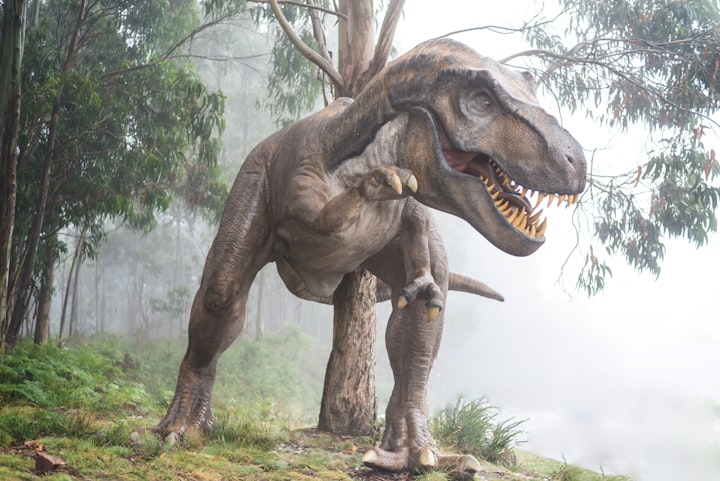DINOSAURS ARE BACK!
What to do if dinosaurs came back to earth

Attention, humans! This is not a drill. Dinosaurs have reappeared on our planet and are currently causing chaos. The most advanced scientific labs are trying to understand how this happened overnight. But until we have some answers, here's what you should do:
Since most of us only know a few select species of dinosaurs, thanks to Jurassic Park, the first thing we need to do is be able to identify different types. Ask yourself, can I tell apart a harmless herbivore dinosaur from a carnivorous one that can eat me? The answer to this might save your life.
Let's quickly review some of the most common herbivores. Make sure to memorize at least one feature of each dinosaur so that you can recognize them if you encounter them. We have the Brachiosaurus, which is 100 feet long and can snap you with its tail. Then there's the Ankyoceratops and Keyceratops, which look like rhinoceros and are about the height of an average-sized human. Remember, no petting! The Atlasaurus looks like a carnivorous dinosaur, but it's harmless. It's very fast, so don't try to race it.
Now, let's talk about the carnivorous dinosaurs. Here's a list of things you shouldn't do with any of the previously mentioned dinosaurs:
Never offer them modern delicacies like pizza or ice cream. These foods are bad enough for us humans, and we don't need large dinosaurs getting stomach aches.
Don't try to domesticate them as pets. Their behavior is unpredictable. We managed to domesticate wolves into dogs, but it might not work with dinosaurs.
Keep your dogs off the leash for a while. Instead, carry them in a backpack or find a way to transport them safely. If a dinosaur is approaching, don't try to scare it with shiny objects or loud noises. This will likely irritate and scare them more.
Avoid pointing flashlights directly at a dinosaur's face. Also, if you have any loud and flashy gadgets, it's best to keep them at home.
Now, let's move on to the top carnivorous dinosaurs you're most likely to encounter. The best thing you can do is run for your life. The odds are that these dinosaurs will be faster than you, so find a safe place where you can lock the door and protect yourself.
Tyrannosaurus Rex: They can be as tall as 12 feet and will likely outrun you in any situation. Don't try to make it play basketball; they are dinosaurs and won't understand the concept.
Velociraptor: These sneaky dinosaurs are as tall as a small child but very swift. Don't attempt to feed them or you might end up being their meal.
Spinosaurus: They are beautiful creatures, but admire them from a distance. They can move on two legs, reach up to 60 feet in size, and have blade-like teeth.
Deinonychus: This small dinosaur may look harmless like a bird, but it's extremely dangerous because it can fly and eats meat.
Confuciusornis: These sneaky dinosaurs might try to enter your window unexpectedly. Use arm protection like arm sleeves or a thick, resistant leather material to block possible bites.
Now that we've covered the basics, let's discuss some action plans for the situation. We have a few options:
Dino Dome: We could build huge, thick glass domes around cities connected by advanced tunnels and suspended highways. This way, we can separate our day-to-day life from dinosaur threats. However, until we can build these domes, we would have to limit our time spent outside.
Dino Defense Squad: We could recruit the strongest and most agile humans to form a dino defense squad. These brave individuals would be responsible for handling the toughest dinosaur emergencies.
Jurassic Diet: We could promote a Jurassic diet where humans eat raw meat, similar to our ancestors. The idea would be to show dinosaurs that we are similar to them, so they don't see us as prey.
Hamster Wheel Traps: This may be a bit mean, but we could build huge hamster wheels to trap dinosaurs and harness their energy to generate electricity. However, this plan is not foolproof.
Personal Hamster Balls: We could create personal hamster balls for every human on the planet to move around safely and avoid dinosaur threats. This plan has its limitations too.
If we decide to transport dinosaurs to another planet, it would require significant technological advancements. We would need a fleet of enormous space shuttles capable of carrying these heavy creatures. Capturing them in the first place could be done using a giant magnet or a network of trampolines. We could also explore the idea of hypnotizing them with a global sound system to guide them to the departure station.
Alternatively, we could consider getting rid of the more dangerous carnivorous and huge herbivorous dinosaurs to ensure the safety of our cities. This way, we can coexist with some dinosaurs on our planet.
These plans may sound absurd, but in this situation, every idea is worth considering. What are your thoughts on this absurd scenario? Do you have any additional ideas to contribute to our crazy plans?





Comments
There are no comments for this story
Be the first to respond and start the conversation.